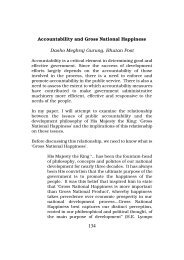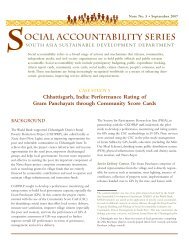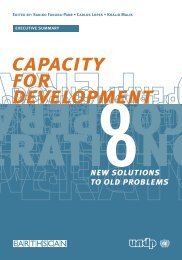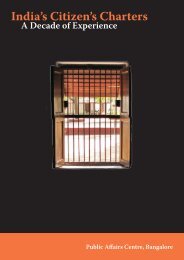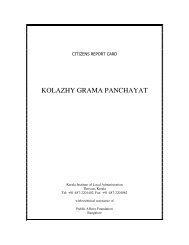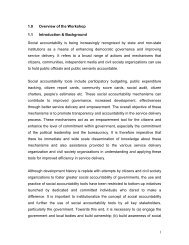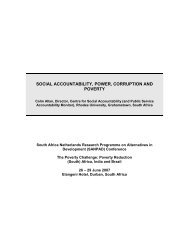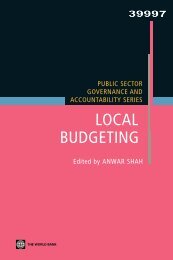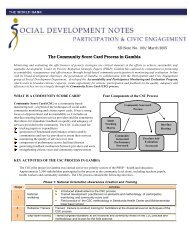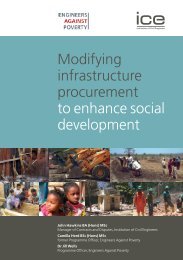Enabling Environment for Social Accountability in ... - SASANet
Enabling Environment for Social Accountability in ... - SASANet
Enabling Environment for Social Accountability in ... - SASANet
Create successful ePaper yourself
Turn your PDF publications into a flip-book with our unique Google optimized e-Paper software.
Currently, the NCAV works <strong>in</strong> six separate but <strong>in</strong>terrelated program areas: comprehensive client services;<br />
gender development and legal re<strong>for</strong>m; child protection; advocacy to change the behavior of male<br />
perpetrators; community mobilization and participation; and a shelter network (NCAV 2005). The NCAV<br />
implements these programs with a 14-member staff,, half of whom have worked <strong>for</strong> the Center <strong>for</strong> more<br />
than five years.<br />
The NCAV shelter network is composed of two shelters with a total of 20 beds. The UB shelter faced a<br />
great deal of resistance when it first opened <strong>in</strong> 1995. Ow<strong>in</strong>g to Mongolian cultural attitudes toward DV, it<br />
took two months <strong>for</strong> the first DV victim to have the courage to come to a shelter. S<strong>in</strong>ce then the beds <strong>in</strong><br />
the shelter have never been empty. This underscores the success of the shelter <strong>in</strong> respond<strong>in</strong>g to DV and<br />
the enormity of this problem.<br />
In June 2004, an NCAV set up a second eight-bed shelter, the Gobi Regional In<strong>for</strong>mation Center, to serve<br />
five neighbor<strong>in</strong>g aimags. Filled to capacity s<strong>in</strong>ce its open<strong>in</strong>g, the Gobi Center receives frequent requests<br />
from other surround<strong>in</strong>g aimags and soums to shelter and assist victims of DV.<br />
The NCAV also operates a transfer facility <strong>in</strong> UB, a one-room hous<strong>in</strong>g unit <strong>for</strong> a woman and her children<br />
who have “graduated” from the shelter and are await<strong>in</strong>g permanent hous<strong>in</strong>g so that they do not have to<br />
return to violence. S<strong>in</strong>ce 2004, the Center has also run a toll-free hot l<strong>in</strong>e <strong>for</strong> DV victims. Meanwhile, the<br />
NCAV has provided counsel<strong>in</strong>g at the Men’s Education Laboratory to prevent DV and rehabilitate male<br />
perpetrators. 55 With a grant from The Asia Foundation, the Center began publish<strong>in</strong>g a newspaper, Helhee,<br />
<strong>in</strong> 1997 to promote public awareness of DV and the organization’s policy advocacy agenda. Between<br />
1997 and 2002, the newspaper’s circulation reached more than 1,000 copies. However, when fund<strong>in</strong>g ran<br />
out <strong>in</strong> January 2002, the NCAV was <strong>for</strong>ced to stop publication; demonstrat<strong>in</strong>g that even Mongolia’s<br />
relatively well-funded CSOs cont<strong>in</strong>ue to struggle with a limited and precarious resource base (F<strong>in</strong>d<strong>in</strong>g<br />
NCAV-1).<br />
S<strong>in</strong>ce 1998, when it first established chapters outside of UB <strong>in</strong> the aimags of Bayanhongor and<br />
Uvorkhangai, the NCAV has expanded to <strong>in</strong>clude branches <strong>in</strong> 13 aimags; the most recent are the Gobi<br />
Center and two remote districts of Ulaanbaatar. These local chapters operate with significant and<br />
consistent volunteer support. Between one and four times a year, the NCAV consults with these<br />
volunteers to provide methodological and professional guidance, and share experiences and strategies.<br />
Despite Mongolian society’s <strong>in</strong>itial misgiv<strong>in</strong>gs, the Center now enjoys an excellent reputation, a trusted<br />
relationship with the M<strong>in</strong>istry of <strong>Social</strong> Welfare and Labor, and regular fund<strong>in</strong>g from both <strong>for</strong>eign donors<br />
and the GoM. Relations between NCAV and the government have generally been positive. In 2004, <strong>for</strong><br />
example, the aimag of Bayanhongor named NCAV’s local chapter as the best NGO <strong>in</strong> the aimag,<br />
recogniz<strong>in</strong>g its collaboration with the local government, its cooperation with other NGOs, and its broad<br />
<strong>in</strong>clusion of the population.<br />
Un<strong>for</strong>tunately, the high turnover of public officials (both civil servants and elected officials) has<br />
adversely affected the NCAV’s relationship with the GoM. Dur<strong>in</strong>g an <strong>in</strong>terview <strong>in</strong> May 2005, the<br />
Center’s director noted that despite years of public advocacy work on DV, the NCAV must cont<strong>in</strong>ually<br />
educate new public officials about DV and the organization’s mission and activities. Nonetheless, <strong>in</strong><br />
contrast with the typically adversarial relationship between CSOs and the GoM, the NCAV has achieved<br />
a high level of NGO-government cooperation.<br />
55 The laboratory was first established by the Mongolian Open Society Forum <strong>in</strong> 1998 and has benefited from the<br />
support of the UB Police Department s<strong>in</strong>ce 2000.<br />
61




